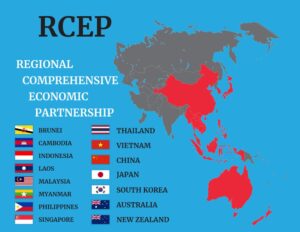 At the end of 2021, we thought COVID-19 pandemic would end with the Delta variant, but the mutant strain discovered in South Africa last November is named as the Omicron and is spreading over the world now. The Omicron variant is said to have a 30% lower incidence of serious illness in unvaccinated people compared to the Delta variant. This might be one of the reasons young people seem to be less wary of the Omicron variant. WHO estimates that as of the end of 2021, the Omicron variant has spread to 110 countries and regions worldwide. The Omicron variant cluster has already occurred at the Belgian Antarctic base. In the U.S., one million cases a day were reported early in January, and more than 95% of them are said to be the Omicron cases. In China, a lockdown began in Xi’an, Shaanxi Province on December 23rd, 2021, and about 13 million people were restricted from going out. Furthermore, on January 8th this year, the Omicron cases were found in Tianjin (population 14 million), and the city was forced into lockdown in effect on January 9th. This is an indication of the Chinese government’s strong will to hold the Winter Olympics in Beijing in February as scheduled.
At the end of 2021, we thought COVID-19 pandemic would end with the Delta variant, but the mutant strain discovered in South Africa last November is named as the Omicron and is spreading over the world now. The Omicron variant is said to have a 30% lower incidence of serious illness in unvaccinated people compared to the Delta variant. This might be one of the reasons young people seem to be less wary of the Omicron variant. WHO estimates that as of the end of 2021, the Omicron variant has spread to 110 countries and regions worldwide. The Omicron variant cluster has already occurred at the Belgian Antarctic base. In the U.S., one million cases a day were reported early in January, and more than 95% of them are said to be the Omicron cases. In China, a lockdown began in Xi’an, Shaanxi Province on December 23rd, 2021, and about 13 million people were restricted from going out. Furthermore, on January 8th this year, the Omicron cases were found in Tianjin (population 14 million), and the city was forced into lockdown in effect on January 9th. This is an indication of the Chinese government’s strong will to hold the Winter Olympics in Beijing in February as scheduled.
According to information from Johns Hopkins University in the U.S., the Delta variant took about three months to reach 50 million infections. The Omicron variant, however, took only two months, which shows this variant is far more infectious. The movement of people during the year-end and New Year holidays have led to the explosive spread of the infection around the world. This will undoubtedly lead to the collapse of the medical system in the immediate future, which is already being overwhelmed at this stage. According to the public health research institute in Germany, additional vaccination is effective against the Omicron variant, and its preventive effect in reducing the incidence is 70-80%, and the effectiveness in aggravation prevention is over 90% for 3-6 months.
In Japan, the number of infected people is doubling every day. The number of cases may be one digit less than in Europe and the U.S., but the reality is that we are in the “sixth wave” of the COVID-19, and yet Prime Minister Fumio Kishida’s policy is not clear. On January 7th, it was decided to apply “semi-emergency coronavirus measures” to Okinawa, Yamaguchi and Hiroshima. On the other hand, the number of people who have completed the booster(third) vaccination in Japan is only 0.7% of the total population, or 870,000 people, as of January 11th, even after three months since the cease of “fifth wave”. At a press conference on January 11th, it was finally decided to bring forward the 8-month vaccination period to 6 months. I sincerely hope that this will not end up to an empty slogan. At leaset, the 9 million doses of stock that we have now should be used as soon as possible. Overseas, booster vaccinations are already being given, and in Israel, the fourth round of vaccinations began on January 3rd for people over 60 years old. The booster vaccination rate has reached 20% in the U.S., 49% in the U.K., 31% in France, and 41.8% as of January 11th in neighboring South Korea.
The low number of infections in Japan is because people are refraining from going out as much as possible. In addition, many people wear masks all the time, especially non-woven masks (including surgical masks), which seems effective as control measures against COVID-19. Urethane masks, which look fashionable and are popular among young people, are not so effective. In Europe and the U.S., people seem to wear urethane masks rather than non-woven masks. I suppose this has made a difference. I hope that the Kishida administration will take an active leadership to achieve Japan’s own economic recovery.
 Regional Comprehensive Economic Partnership (RCEP) agreement came into effect on January 1st, 2022, with a total of 15 member countries, including Japan, China, South Korea, and the Association of Southeast Asian Nations (ASEAN). By eliminating or lowering tariffs and promoting economic activities, a huge economic zone has been created with a population of approximately 2.27 billion people in the region and a gross domestic product (GDP) of approximately 25.8 trillion dollars, which accounts for about 30% of the whole world. The Japanese government expects GDP increase by 2.7%. For Japan, this is an economic partnership on par with the Trans-Pacific Partnership (TPP). I look forward to the revitalization of Japan’s trade and investment in the Asia-Pacific region and the rapid restructuring of the supply chain.
Regional Comprehensive Economic Partnership (RCEP) agreement came into effect on January 1st, 2022, with a total of 15 member countries, including Japan, China, South Korea, and the Association of Southeast Asian Nations (ASEAN). By eliminating or lowering tariffs and promoting economic activities, a huge economic zone has been created with a population of approximately 2.27 billion people in the region and a gross domestic product (GDP) of approximately 25.8 trillion dollars, which accounts for about 30% of the whole world. The Japanese government expects GDP increase by 2.7%. For Japan, this is an economic partnership on par with the Trans-Pacific Partnership (TPP). I look forward to the revitalization of Japan’s trade and investment in the Asia-Pacific region and the rapid restructuring of the supply chain.
According to the U.S. Department of Labor’s employment statistics released on January 7th, the number of workers in nonfarm sector increased by 199,000 from previous month, and the unemployment rate was 3.9%, an improvement of 0.3% from 4.2% in November. In search of higher wages and better working conditions, the economic recovery has led to an increase in the number of people leaving the entertainment and hospitality, retail, and health care industries, where the risk of COVID-19 infection is high. As a result, the supply and demand balance for labor is tightening, and a serious labor shortage continues. However, the current number of workers is 3.6 million less than the pre-Corona February 2020, so there is still room for improvement. In 2021, the number of workers increased by 6.45 million, the highest increase on record since statistics began in 1939. We feel the underlying power of the U.S.
The turmoil in the global supply chain has not subsided, and the congestion at major ports in Europe and the U. S., which is one of the causes of turmoil, is continuing. Currently, around 100 container vessels are waiting for berth in the ports of Los Angeles and Long Beach (LA/LB) on the West Coast of the U.S. I don’t think introducing a surcharge on long-stay cargo can be a drastic solution. On top of that, it showed the high positive rate of 80% in the COVID-19 inspection conducted on January 4th at both ports, and the possibility of even more delays is expected in port operations due to difficulty to secure the necessary dockworkers. As a result, shipping lines are experiencing significant delays in their vessel schedule, and are sarcastically called as “tramper operators”. The problem of skyrocketing ocean freight will continue until the port congestion in the North America and LA/LB is resolved.
The price of new containers at the end of December was $3,550 per 20f, a decrease of $200 per 20f, or 5.3%, from the November price of $3,750 per 20f. This is the third consecutive month of price declines since last September, and $500 per 20f or 11% decline since the highest price of $4,000 per 20f in June 2021. New container production in December was 561,311 TEU (Dry: 538,616 TEU, Reefer: 22,695 TEU). The annual production volume of new containers reached 7,000,930 TEU (Dry: 6,614,722 TEU, Reefer: 386,208 TEU), surpassing the 7 million TEU. This is the highest annual production volume of dry and reefer containers in the past 10 years, which is an astounding achievement considering the situation in the second half of 2021 when production had to be suspended temporarily due to power supply restrictions. As of the end of December, the new container inventory at manufacturing companies was 818,644 TEU (Dry: 760,918 TEU, Reefer: 57,726 TEU), an increase of 59,196 TEU or about 8% over last month. Container operation ratio was almost 100% for most leasing companies, which proves how unprecedentedly active the market was in 2021.
 Last year, EFI received orders for three Kalmar Reachstackers. We were able to deliver the first one to Kambara Logistics on December 22nd. It can handle containers up to 5 stacking high, and is equipped with a tilting spreader that can be tilted up to 55 degrees. The delivery was reported in a trade newspaper on December 24th. The paper quoted my comment, “We are very proud to have the opportunity to introduce this equipment, and we hope that many of our customers will introduce Kalmar Reachstackers in the future, which we believe will greatly contribute to the business expansion of our valued customers.”
Last year, EFI received orders for three Kalmar Reachstackers. We were able to deliver the first one to Kambara Logistics on December 22nd. It can handle containers up to 5 stacking high, and is equipped with a tilting spreader that can be tilted up to 55 degrees. The delivery was reported in a trade newspaper on December 24th. The paper quoted my comment, “We are very proud to have the opportunity to introduce this equipment, and we hope that many of our customers will introduce Kalmar Reachstackers in the future, which we believe will greatly contribute to the business expansion of our valued customers.”
Besides Kalmar Reachstackers, EFI also offers a wide range of products such as Thermo King SuperFreezer which maintains -60’C, Magnum Plus which maintains -40’C, and generators, TydenBrooks Super Bolt Seal, which requires 4.5 tons of shear strength, and Security Seals, JJAP ISO tank containers, and Mirai Hi-Tech Chassis. In addition, highly appreciated our aftermarket service by our many customers. Therefore, we hope you will consider to introduce these products backed by our highly trusted aftermarket service.
(Translated by Ms. Chizuru Oowada)